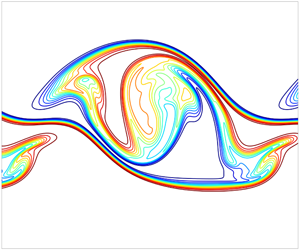No CrossRef data available.
Article contents
Instability of a dense seepage layer on a sloping boundary
Published online by Cambridge University Press: 14 January 2020
Abstract

When open-cut mines are eventually abandoned, they leave a large hole with sloping sides. The hole fills with rain water, and there is also contaminated run-off from surrounding land, that moves through the rock and eventually through the sloping sides of the abandoned mine. This paper considers a two-dimensional unsteady model motivated by this leaching flow through the rock and into the rain-water reservoir. The stability of the interface between the two fluids is analysed in the inviscid limit. A viscous Boussinesq model is also presented, and a closed-form solution is presented to this problem, after it has been linearized in a manner consistent with Boussinesq theory. That solution suggests that the interfacial zone is effectively neutrally stable as it evolves in time. However, an asymptotic theory in the interfacial region shows the interface to be unstable. In addition, the nonlinear Boussinesq model is solved using a spectral method. Interfacial travelling waves and roll-up are observed and discussed, and compared against the predictions of asymptotic Boussinesq theory.
- Type
- JFM Papers
- Information
- Copyright
- © The Author(s), 2020. Published by Cambridge University Press




